How to Analyse the Game of Football? [Football Tactical Analysis for Beginners]

Introduction
When starting to analyse the game of football, the first question is likely to be what to observe. Most football fans or even aspiring analysts hardly learn football tactics systematically. I have just graduated from University of South Wales and obtained BSc Football Coaching and Performance degree, but there were no opportunities to learn football tactics one by one, although there was only a two-hour session for tactical analysis in UEFA B licence lecture included in the university course. Therefore, those who want to learn football tactics need to gather partial information from books or articles.
In this circumstance, I believe understanding a framework of the analysis process is extremely beneficial. More importantly, keeping improving the framework by watching and analysing many games is the necessary process to understand tactics of football.
In this article, therefore, the framework I often used when analysing a game is going to be explained in detail. I hope you make the most of it and develop your own framework.
Players, Systems & Strategies
The preparation before the game is extremely important to analyse the game better. The quality of available information before the game differs, but understanding who will start the game is possible for most professional games and this is the key information. This is because ultimately tactics are determined by the profiles of the players. It might be difficult to know it when analysing teams which it is the first time to watch, but during the analysis process of the game, it is important to try to understand what kind of players they are. When analysing famous or familiar teams, differences of the selection of the players from the previous game need to be considered to identify what the manager plans for the game. Overall, although the main focus of this article is providing the analysis framework of tactics as a team, it is important for you to recognise the importance of the profiles of individual players.
As soon as the game begins, the first thing to do is understanding the systems. Since some teams change the shape depending on each area of the pitch, in my framework, the systems are checked in the defensive third, midfield and attacking third. The reason why systems can be tweaked in each area is based on the structure of the game of football. The article below explained this idea in detail.
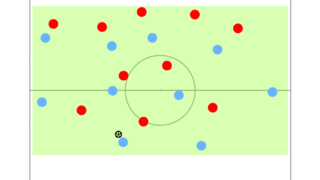
Even though there is criticism that systems are no longer important in modern football, the difference of systems creates overloads and underloads in some areas on the pitch, which gives both managers problems they need to solve. The problems are likely to be related to how to find and defend spare players on the pitch and this is where tactics have responsibilities.
Additionally, not only just understanding the shape in each area but also how they play in the system needs to be observed. The detail should be considered later, but how aggressively they press and how much they play long balls instead of short passes are important information. If a team presses high and applies pressure even towards the opposition goalkeeper or plays more short passes under pressure, the team seems to accept some risks and try to dominate the game. On the other hand, if a team chooses to set a compact block in the midfield or own half or plays long balls a lot, the team might focus on reducing risks and playing passively. Some teams might change the way to play as the game progresses, but how they start the game is key information to guess the plan of each manager.
Overall, before observing detail things on the pitch, it is recommended to understand the players, systems and how the teams start the game. Then, the next step is analysing tactics of each phase in detail.
Tactical Analysis
In this section, important factors in possession, out of possession and set pieces are going to be discussed.
In Possession
The phase of in possession can be divided into the phase of build up and final third attacking. In the phase of build up, a team tries to progress the ball and break the opposition lines, while the objective becomes just scoring a goal in the final third. Therefore, they need to be considered separately.
Build up
When considering breaking the opposition lines, the number of lines needs to be understood. Usually, there are three lines in a defensive shape such as a 4-4-2 or 3-4-3, but sometimes there are four lines in a specific structure such as a 4-3-1-2, 3-4-1-2 or 4-1-4-1. However, when defending with the shapes which consist of four lines, at least one of the lines only has a player, so it is possible to regard it as an extra player between the back line and midfield line or the midfield line and forward line and still consider that the shapes have three main lines. Therefore, in the build up phase, how to break these three lines is the main factor to analyse.
Firstly, how to play out from the back against the opposition forward line are going to be observe. The objective of the situation where a team possesses the ball in front of the opposition forward line is mainly finding a spare player behind the line or playing long balls.
When trying to break the line by a short pass and find a spare player behind the line, the key is obviously if there is a spare player behind the line. Since the system in this area has been observed firstly, it was already estimated if there is a spare player or not. Therefore, what needs to be observed now is how the opposition team deals with the spare players and how the team in possession create a spare player in case nobody is free behind the line. Additionally, the ability of carrying the ball to break the opposition forward line is a valuable skill for centre backs, so the profiles of centre backs are also crucial.
On the other hand, when the team in possession aims to play long to progress the ball forwards, who plays it and is targeted is a key point. As it was mentioned earlier, the profiles of players are extremely important and long balls and aerial duels highly depend on individual skills. In terms of tactics, it is essential to watch if the player who plays long balls can do it comfortably. Under intense pressure, it becomes difficult to play long precisely. Therefore, creating and finding a spare player at the back is an important tactical factor. Additionally, the structure of securing second balls is also vital. This was explained in detail in the article below.

Secondly, against the opposition midfield line, the objective becomes finding an attacker between the midfield and back line or in a wide area. Especially when playing against a team which strikers do not press, it is easy to keep the possession and break the opposition forward line. However, those teams tend to be compact and close the middle well in the midfield. In this case, what often happens is the team in possession circulates the ball from one side to the other. This is not optimum situation for the attacking team because it is easy for the team out of possession to defend and lock the ball in a compact area to win it. Thus, one of the important things is breaking the opposition midfield line through the middle. The article below analysed how to exploit the space between the lines.
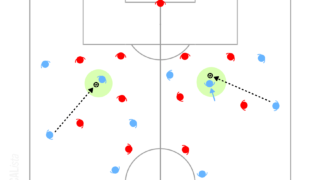
When the team in possession cannot play through the opposition midfield line, it is because the players in front of the opposition midfield line miss the timing to play through or the attackers between the lines are not in a proper position and do not prepare for receiving the ball. To identify the cause is one of the most important parts when analysing the game.
Finally, after breaking the opposition midfield line or playing long from the back, the objective is breaking the opposition back line. When playing long, there is no need to break the opposition forward or midfield line and the question is if they can use the space in behind the opposition back line. Especially, when the opposition team presses high with marking all outfield players, the goalkeeper or centre backs often play long balls, so this becomes the main topic of building up.
Similar to when trying to break the opposition midfield line, if the team in possession cannot use the space in behind, it is because nobody makes a run in behind or the timing or accuracy of the long balls is not proper. Additionally, when playing long, the profile of a target player up front should be also considered because the aerial duels highly depend on the individual skills.
Final Third Attacking
In the final third, how many big goal scoring opportunities are created is the main measure to evaluate the quality of final third attacking. In this area, the profiles of attackers extremely matter. If there is a tall and strong attacker in the box, delivering many crosses can be effective. Additionally, if there are any players who can deliver precise crosses or dribble into the box should be identified because those individual skills are crucial in the final third.
In terms of tactical points, how to deliver the ball into the box is key. Maybe it is a simple cross if there is a strong striker in the box, but generally it is more effective to penetrate into the box and then take a shot or deliver cut backs closer to the goal. In this case, playing through the channels or exploiting the space in front of the box is crucial. It depends on how the opposition team defends, but identifying gaps in the opposition defensive block and exploiting them are the key.
Defensive Transition
In terms of the defensive transition, preventing the opposition team from playing counterattacks and winning the ball back as quickly as possible are important.
Especially in the own half, as soon as losing the ball, all players need to come back to defend the goal quickly. The speed of the transitions is crucial to prevent the opposition team from playing counterattacks and taking a shot closer to the goal.
However, in the opposition half, preventing counterattacks is not enough. Not only just delaying the opposition counterattacks but also winning the ball back as soon as possible is required to keep attacking in the opposition half. To achieve this, the players around the ball need to apply pressure on the ball and the players away from the ball are required to shuffle across to the ball side to lock the opponents in.
These are the analysis points of defensive transitions.
Out of Possession
In the phase of out of possession, like in possession, the phase of pressing and the phase of final third defending are going to be analysed.
Pressing
Firstly, it is generally important to keep the shape compact out of possession. Observing the position of the forward line and back line is helpful to measure the vertical compactness. However, there is an exception. If a team tries to press high with man marking, the shape cannot be compact. Therefore, identifying how much the team out of possession focuses on keeping the lines and shape tight or marking the opposition players is the first step to analyse the tactics of defending teams.
Moreover, observing how much the opposite side players can contribute to keep the shape horizontally compact by shuffling across is also an important factor. The opposite side winger can often be lazy to do this, but the effort of the winger is extremely important to press high or defend well. The article below explained the detail of zonal defending and basic of defending in modern football.
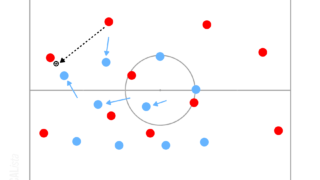
When analysing the structure of pressing, the first step is identifying where they start to apply pressure on the ball by observing the pressing trigger such as the pass to one of the opposition centre backs or to one of the fullbacks. As it is mentioned in the article above, when the pressing is triggered, the players around the ball tend to find opposition players to mark tightly. Therefore, observing this situation can help to understand what the trigger is.
After understanding how they press, the quality of pressing should be evaluated. Just forcing the opposition player to kick the ball away is not enough, but whether the ball is actually regained is the most important. Even though the pressing is intense and forces the opposition player to play long, there are second ball battles. Thus, the structure of securing second balls should be also analysed.
When setting a compact defensive block, the point is whether they can close the middle. The players need to shuffle across to keep the compactness horizontally and the gaps between each player on the same line closed. Additionally, the resilience of the back line against long balls in behind is also crucial. In the midfield, the opposition defenders can easily play long in behind, so the back line needs to be controlled and organised well to defend against long balls.
Final Third Defending
In the final third, the ultimate objective is defending the goal. Therefore, preventing the opposition attackers from taking a shot comfortably in the box is extremely important. To do this, especially centre backs and defensive midfielders should be in front of the goal. However, this can weaken the defence in wide areas. Therefore, some of them might be required to step out to defend wide areas. Of course, this weakens the protection in front of the goal against crosses, so the balance of the positions of centre backs and defensive midfielders is the key point to be considered.
Additionally, parking the bus forever is not realistic and the opponents would score a goal sometime. Thus, pushing the lines up is necessary and the quality of this from especially the back line is a key point.
Attacking Transition
As soon as winning the ball, securing the possession or playing a counterattack can be an option. To secure the possession, the players need to spread out quickly to play the ball away from the opposition pressure and change the shape into the system for attacking. When playing a counterattack, the ball must be played quickly forwards. Therefore, who can receive it up front and who makes an overlapping run are the analysis point when playing counterattacks.
Set Pieces
In terms of set pieces, some of them are completely different games, so some articles about them are attached below.
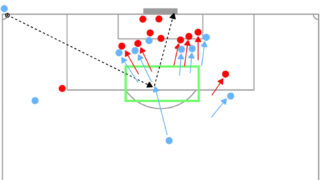
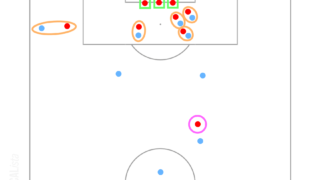
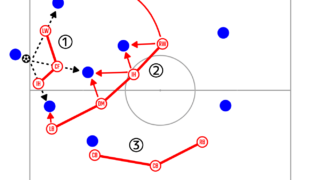
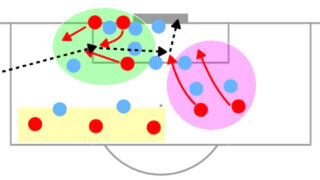
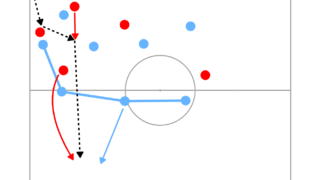
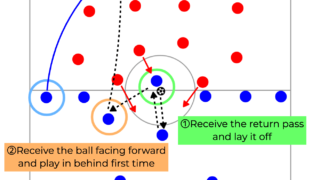
When mainly analysing open play, goal kicks are an extremely vital set piece. This is because both teams can set the shape perfectly and they can play a planned pattern. Therefore, tactics of goal kicks are underpinned by the tactics of building up or pressing, so it can tell the philosophy of the team.
Conclusion
This is not a perfect framework. I am still improving this idea and I would like you to develop your own method based on this. Therefore, I would like to know what you think about this framework honestly in twitter. Thank you for reading. I hope you enjoyed this article.


